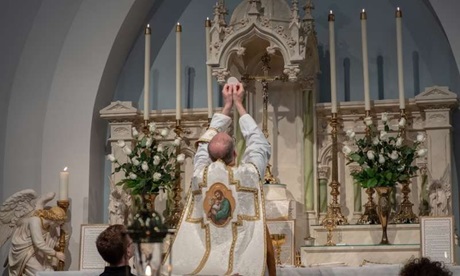Recently rumors have been flying that Pope Francis is preparing to impose stringent restrictions on the Traditional Latin Mass.
Of course, unfounded rumors out of the Vatican are not new, and some journalists have not been able to identify anybody who has actually seen the document in question.
Still, even if it ends up being in the class of “Pope Francis is dying” rumors that we have heard for years, such a document would be in character for a pontificate that has emphasised placing hedges around the more conservative, traditional elements of the Church.
While his predecessor’s position towards the Latin Mass community can be broadly characterized as one of accommodation, Pope Francis has taken a more confrontational approach.
But why? What is the problem with allowing what is by all measures a small fraction of Catholics to participate in a licit Mass that they find beautiful, reverent, and holy?
The very real fact is that Traditional Latin Mass (TLM) participation has been associated with factions inside the Church who do not accept Vatican II and may even be quasi-schismatic, and multiple popes have taken a variety of approaches in how to deal with groups such as the SSPX.
It is not our place to tell the Holy Father what to do; we are social scientists, not bishops, and one of us is not even Catholic.
However the extent to which the TLM community is a schismatic hotbed of negative attitudes towards Vatican II is ultimately an empirical one that is scientifically investigable, and on this point there has been a clear lack of objective, systematically collected data.
The Latin Mass today
The Prefect for the Dicastery for Divine Worship, Cardinal Arthur Roche, has made it clear that he thinks the TLM has a different liturgical theology than the Novus Ordo.
There is also the argument that the TLM is an implied, if not explicit, rejection of Vatican II. It seems the Holy Father himself holds this view. Conclusions based on impressions are suspect if they are not supported by more objective evidence.
In announcing Traditiones Custodes (the 2021 round of Latin Mass restrictions), the Pope invoked a survey that he had disseminated among bishops on the question of the Latin Mass.
However, in addition to the fact that the survey was of bishops and not Traditional Latin Mass-goers themselves, the wordings used, the exact responses, the representativeness — any one of many things that would be required for a professional survey statistician to objectively gauge the validity of the survey — were completely unknown.
Therefore it is difficult to know how seriously to take the results of the survey when only the vaguest details are known.
Objective data collection
We, a professor of sociology and theology (and a TLM attender) and a demography/sociology dual-PhD data scientist, have been striving to remedy the lack of transparent, systematically collected, objective data on the TLM community in preparation for a book we are writing.
This involves collating all previously published information on the demographics and attitudes of the TLM community (it is not a lot), as well as conducting our own surveys and supplementing our quantitative data with approximately 20 in-depth, semi-structured interviews of TLM Catholics across the country.
While our study is on the United States TLM community in particular, given the American Church’s reputation as a hotbed of conservativism, we believe our findings have broad implications.
Survey findings
So what did we find? While we are still processing our data, some relevant themes have already emerged.
There is obviously a lot to talk about with TLM Mass-goers, which we will discuss in greater detail in the book, but in broad strokes, this is some of what we learned about Traditional Latin Mass Catholics in the United States:
There is some truth to the conventional wisdom that they tend to be politically conservative. Of the 446 respondents in our survey who attend the Traditional Latin Mass at least once per year, 77 percent of them lean Republican.
They are very, very pro-life. 85 percent of the TLM Catholics in our sample believe that abortion should be illegal in all cases, whereas 13 percent believe it should be illegal in most cases, while only 1.6 percent believe it should be legal in most cases, and less than 1 percent believe that it should be legal in all cases.
They are orthodox. In our survey only 2 percent% of TLM Catholics believe that the bread and wine of communion are symbols, as opposed to the Real Presence, of the body and blood of Christ. In a similarly worded Pew survey of general Catholics, 69% considered the Eucharist a symbol.
They generally accept the Second Vatican Council. When we asked “I accept the teachings of Vatican II”
- 4 percent – Strongly disagreed
- 7 percent – Disagreed
- 10 percent – Somewhat disagreed
- 15 percent – Neither agreed nor disagreed
- 15 percent – Somewhat agreed
- 27 percent – Agreed
- 22 percent – Strongly agreed
This is a case where the interview data helped flesh out the reasons for the ambivalence in the survey responses.
A very common theme found in our interviews was distinguishing between what was actually in the Vatican II documents and how it had been carried out or interpreted. Read more
- Stephen Bullivant holds professorial positions at St Mary’s University, London and at the University of Notre Dame, Sydney.
- Stephen Cranney is a data scientist and a non-resident Fellow at Baylor’s Institute for the Studies of Religion.
News category: Analysis and Comment.




